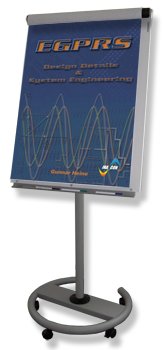 EGPRS - Design Details & System Engineering
EGPRS - Design Details & System Engineering
[2-day course, Euro 2,350.- (net) per participant]
A Comparison Between GPRS Rel. 99 and EGPRS

- International Frequency Allocation
- The EDGE Family
EGPRS, ECSD, Compact EDGE, UWC-136 - EGPRS Specific Changes
Changes of the Protocol Stack, EGPRS Specific Hardware Upgrades, Options for Routing 64 kbit/s Channels to the BTS, Comparison of GPRS and EGPRS in the Physical Layer, Comparison of GPRS and EGPRS in the RLC/MAC Protocol, Comparison of GPRS and EGPRS in the Higher Layers - Improvements of EGPRS vs. GPRS
Alternative Modulation Scheme 8-PSK, Enhanced BEC, Enhanced FEC, Enhanced Network Access
 The Physical Layer of EGPRS
The Physical Layer of EGPRS
- Modulation Schemes in GSM
The In-Phase – Quadrature (I/Q) Presentation, GMSK-Modulation, 8-PSK Modulation, 3PI/8 Offset 8-PSK - Consequences of Using 8-PSK Modulation
Higher Throughput Rate over the Air, Interference Vulnerability, Amplifier Constraints, Shrinking Cells - EGPRS and GPRS – Concerns for Simultaneous Operation
USF-Detection, 8-PSK Reception by a GPRS-only Mobile Station, Blind Detection, Synchronization of GPRS and EGPRS Mobile Stations, USF Detection Issues
 Forward Error Correction and Channel Coding
Forward Error Correction and Channel Coding
- The Data Processing Chain
Channel Coding, The Effects of Channel Coding, The Perspective of the Receiver, The Channel Decoding Process - Puncturing
The Principle of Puncturing, Puncturing in GSM, GPRS and EGPRS, The Perspective of the Receiver, Using Different Puncturing Schemes for Retransmission, Puncturing Scheme Selection - Incremental Redundancy
Principles, Incremental Redundancy – Operation in the Decoder - Tail Bits
Reasons for Appending Tail Bits, Disadvantages of Tail Bits, Example for Tail Bits in Operation - Tail Biting
The Concept of Tail Biting, Pros and Cons of Tail Biting - The Modulation and Coding Schemes in EGPRS
Overview of Channel Coding in EGPRS, MCS-1 – MCS-4 in Downlink (Header Type 3), MCS-1 – MCS-4 in Uplink (Header Type 3), MCS-5 and MCS-6 in Downlink (Header Type 2), MCS-5 and MCS-6 in Uplink (Header Type 2), MCS-7 – MCS-9 in Downlink (Header Type 1), MCS-7 – MCS-9 in Uplink (Header Type 1)
Distinction of the Header Types 1, 2 and 3 - The Data Block Families
Data Block Family A, B and C, Family A Padding - Throughput Rates with MCS-1 – MCS-9
Facts Sheet for MCS-1 – MCS-9, Graphical Presentation of the Performance of MCS-1 – MCS-9
 Establishment, Operation and Release of Packet Transfer Mode
Establishment, Operation and Release of Packet Transfer Mode
- Overview
Access to the Network / Access to the Mobile Station, Resource Allocation / Uplink & Downlink, TBF-Active / TBF-Operation, TBF Release / Uplink & Downlink - Network Access Mechanisms in EGPRS
Applicable Network Access Messages, Format and Use of the EGPRS_PACK_CHAN_REQ-Message, One- and Two-Phase Packet Access Procedure in EGPRS, Network Access on CCCH, EGPRS One-Phase Packet Access on CCCH in Detail, EGPRS Single Block Packet Access on CCCH in Detail, Network Access on PCCCH, EGPRS One-Phase Packet Access on PCCCH in Detail, EGPRS Two-Phase Packet Access on PCCCH in Detail - EGPRS TBF Operation
TBF-Operation Modes - Acknowledged Operation – Important Aspects
The Window Size ‘k’, Maximum Number of Retransmissions, Acknowledgements, Roundtrip Time ( Window Size, The Window Size in EGPRS, Polling for Downlink Acknowledgements in EGPRS, Interpretation of the Reported Bitmap (RB), Compression of the Reported Bitmap (RB) - TBF Operation with ARQ I (Resegmentation)
The Perspective of the Receiver, Determination of Suitable MCS for Retransmission, ARQ I in Operation - TBF Operation with ARQ II (Incremental Redundancy)
The Perspective of the Receiver, Determination of Suitable MCS for Retransmission, ARQ II in Operation - Uplink TBF-Release in EGPRS
Overview, The Countdown Procedure in EGPRS
 Formal Considerations of the RLC/MAC Protocol
Formal Considerations of the RLC/MAC Protocol
- Specific RLC/MAC-Messages with EGPRS
EGPRS_PACK_CHAN_REQ, ADD_MS_RAD_ACC_CAP, EGPRS_PACK_DL_ACK - The RLC/MAC Data Block Formats with EGPRS
Downlink RLC/MAC Data Block Format with Header Type 3, Downlink RLC/MAC Data Block Format with Header Type 2, Downlink RLC/MAC Data Block Format with Header Type 1, Uplink RLC/MAC Data Block Format with Header Type 3, Uplink RLC/MAC Data Block Format with Header Type 2, Uplink RLC/MAC Data Block Format with Header Type 1 - Information Elements within the RLC/MAC Data Blocks
The Uplink State Flag (USF), The EGPRS Supplementary / Polling Field (ES/P), The Relative Reserved Block Period Field (RRBP), The Temporary Flow Identity Field (TFI), The Power Reduction Field (PR), The Block Sequence Number Fields (BSN 1 and BSN 2), The Coding and Puncturing Scheme Field (CPS), The Split Block Indicator Field (SPB-field), The Extension Bit (E-bit) in the Mandatory Part of the RLC-Header, The Final Block Indicator Bit (FBI-bit), The Retry Bit (R-bit), The Stall Indicator Bit (SI-bit), The Countdown Value Field (CV), The Resent Block Bit (RSB-bit), The Packet Flow Identifier Indicator Bit (PI-bit), The TLLI Indicator Bit (TI-bit), The Extension Bit (E-bit) and the Length Identifier Field (LI-field), The Packet Flow Identifier Field (PFI-field), Spare Fields
v1.5
ℹ️ Try out the updated search below!
Search:
More Info:
General Information about this course
Schedule of this training course
Extract of this training course
Buy this book
INACON eBooks
Please have a look at our full offer

